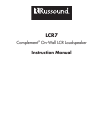
4
INSTALLATION
Prewiring
Run a separate two-conductor stranded copper speaker
cable of at least 16 AWG (1.5 mm) from the amplifi er or
receiver to each speaker. Leave ample cable at the head
end to reach the amplifi er terminals. Label the cables so
you will know which cable connects to each channel.
We recommend running the cables through the walls to
the speaker locations whenever possible so as to hide
them. Be sure to use cable with the appropriate fi re
resistance rating for the application. Check the local
building code for specifi c requirements. Russound offers
a two-conductor speaker cable with a Class 3 fi re rating
for in-wall installation.
When running a speaker cable parallel to an AC power
cable, keep them at least 12 inches (30 cm) apart to
minimize electromagnetic interference. If the speaker
cables must cross AC wiring, cross them at right angles.
At each speaker location, bring the speaker cable out of
the wall in the center of the mounting bracket, leaving
about 2 feet (0.6 m) for connecting to the speaker.
Installing the Mounting Bracket
Note: The mounting bracket must be securely attached
to the wall. For a standard hollow wall, we recommend
screwing the bracket to the wall studs if possible. If the
speaker must be mounted between studs, use at least
three expandable hollow-wall anchors to secure the
bracket. For a masonry wall, use suitable anchors.
Installation on a hollow wall
1. Once you have determined roughly where the speak-
ers will be mounted, use a stud fi nder to locate the
wall studs and mark their location.
2. Position the provided template where you want each
speaker, making sure to leave enough clearance for
rotating the speaker in the mounting bracket. Mark
the mounting screw locations.
3. If you are attaching the bracket to studs, use a small
drill to make pilot holes for the mounting screws. If
you are using hollow-wall anchors, use a drill of the
size recommended by the anchor manufacturer.
4. Screw the mounting bracket to the wall studs with
appropriate screws, or secure the wall anchors in the
wall and attach the bracket to them.
Installation on masonry
1. Obtain masonry anchors suitable for the wall material.
2. Position the provided template where you want each
speaker, making sure to leave enough clearance for
rotating the speaker in the mounting bracket. Mark
the mounting screw locations.
3. With a masonry drill, make pilot holes for the anchors.
4. Attach the bracket to the wall with the anchors.
Connecting the Speaker
Connect the speaker cable before attaching the speaker
to the mounting bracket.
1. Strip 3 to 4 inches (7.6 to 10 cm) off the end of the
cable jacket. Then strip ½ inch (1.3 cm) of insulation
off the two wires.
2. Make sure the wire strands are twisted together so
there are no strands separated from the bundle.
3. Connect the wires to the speaker terminals, being sure
to observe proper polarity. For standard speaker cable
with red and black wires, connect the red wire to the
red positive (+) terminal and the black wire to the
black negative (–) terminal.
Note: Some speaker cables may have other ways of
designating polarity. For example, cable with a clear
jacket usually has a copper-colored wire for positive and
a silver-colored wire for negative. In a cable with white
and black wires, the white is positive and the black is
negative. Cable with both wires the same color may have
grooves, ribs, or stripes on the positive wire.
4. Check to make sure there are no stray strands of wire
outside the terminals. If there are, remove the wire,
twist the strands together, and reconnect the wire to
the terminal.
Speaker cable connection










